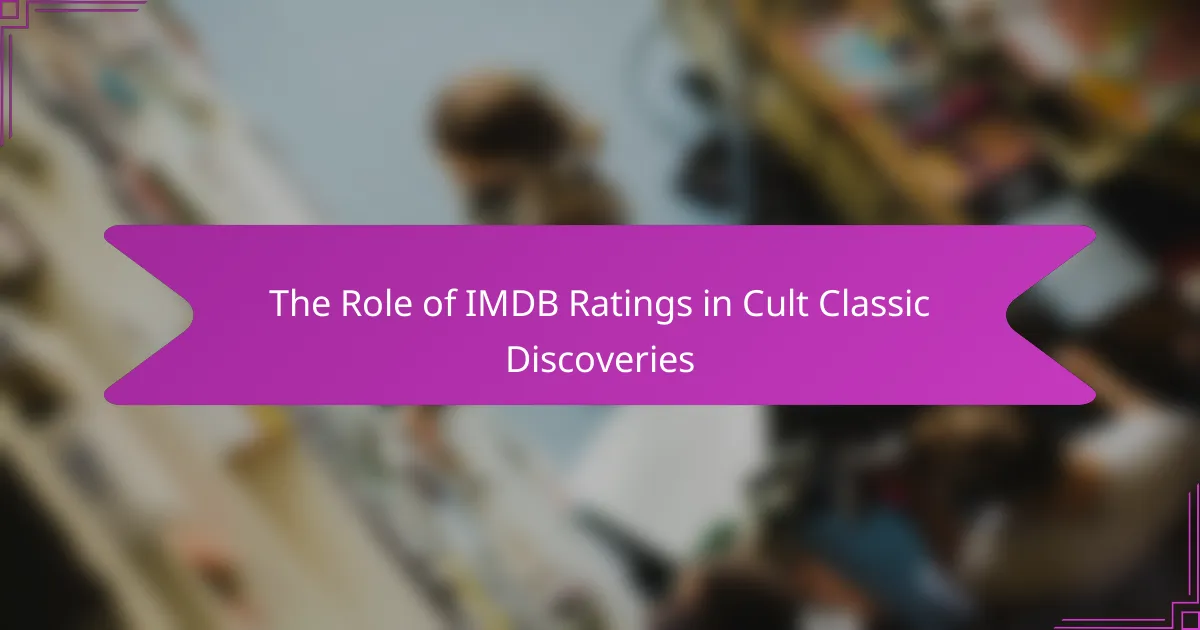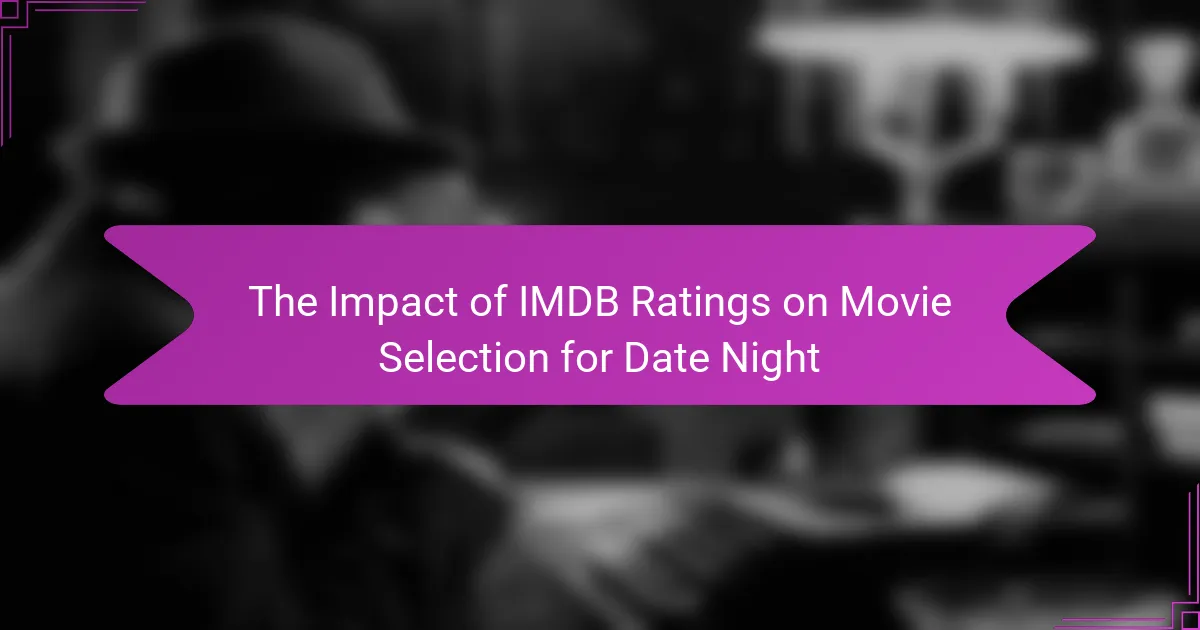IMDB ratings serve as a valuable tool for discovering cult classics by offering a numerical snapshot of viewer opinions and engagement. These ratings can direct audiences to hidden gems that, while not mainstream hits, have developed passionate followings due to their unique storytelling and memorable characters.
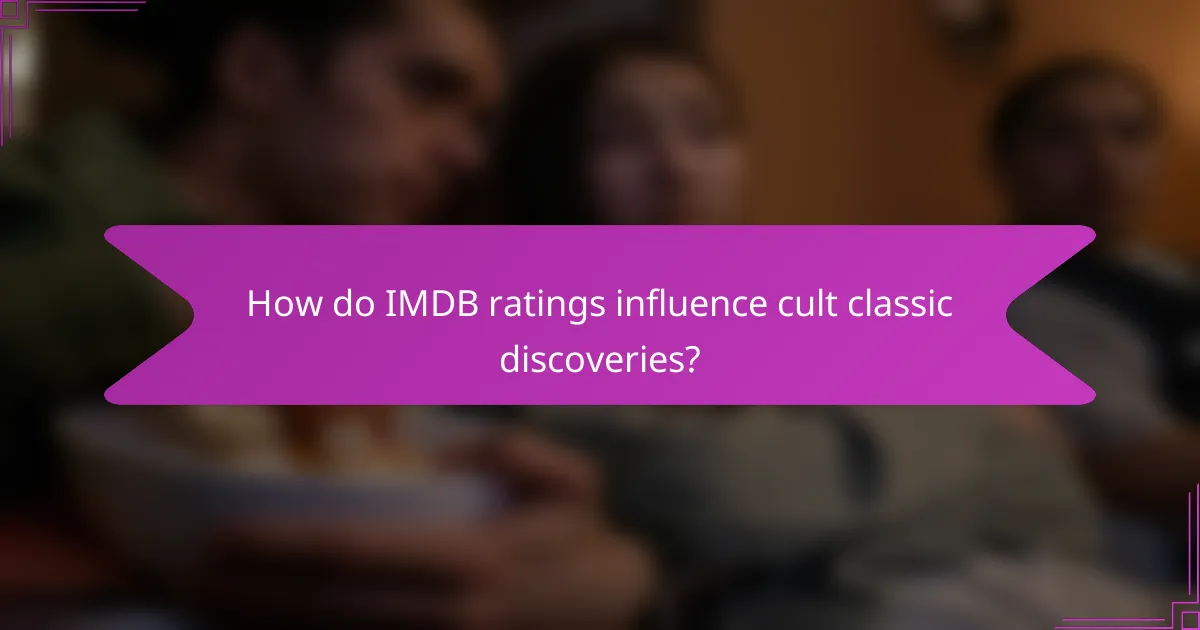
How do IMDB ratings influence cult classic discoveries?
IMDB ratings play a significant role in uncovering cult classics by providing a numerical representation of viewer opinions. These ratings can guide audiences toward lesser-known films that have garnered a dedicated following despite not achieving mainstream success.
Highlighting hidden gems
IMDB ratings can help identify hidden gems that may not be widely advertised. Films with ratings in the low to mid-seventies often indicate a solid fan base, suggesting that while they may not be blockbuster hits, they resonate with viewers on a deeper level. For example, movies like “The Room” and “Donnie Darko” gained cult status largely through word-of-mouth and their unique ratings.
Additionally, browsing through films with ratings below average can sometimes lead to unexpected finds. Many viewers enjoy exploring these lower-rated films, as they often feature unconventional storytelling or unique artistic choices that appeal to niche audiences.
Shaping viewer perceptions
IMDB ratings significantly shape how viewers perceive films, often influencing their willingness to watch them. A film with a high rating may attract more viewers, while those with lower ratings might be overlooked despite their potential for cult status. This phenomenon can create a self-fulfilling prophecy where only the most popular films receive attention.
Moreover, the ratings can affect discussions around a film’s quality and legacy. As audiences engage with these films, they contribute to the ratings, which in turn can elevate a film’s status over time, transforming it into a cult classic. Engaging with community reviews and discussions can provide additional context that enriches the viewing experience.

What are the top cult classics identified by IMDB ratings?
IMDB ratings play a significant role in identifying cult classics, as they reflect audience engagement and appreciation over time. Films like “The Room” and “Donnie Darko” have garnered dedicated followings, often due to their unique storytelling and memorable characters, which resonate with niche audiences.
The Room (2003)
“The Room,” directed by Tommy Wiseau, is often cited as one of the best worst movies ever made. Its disjointed plot, awkward dialogue, and peculiar performances have led to midnight screenings where fans interactively engage with the film, creating a communal experience.
Despite its low IMDB rating, “The Room” has achieved cult status due to its unintentional humor and the fervor of its fanbase. Viewers often recommend it for a fun viewing experience, especially in group settings where the absurdity can be fully appreciated.
Donnie Darko (2001)
“Donnie Darko,” directed by Richard Kelly, combines elements of psychological thriller and science fiction, making it a thought-provoking cult classic. Its exploration of time travel, mental health, and teenage angst resonates with many viewers, leading to a dedicated following that appreciates its complex narrative.
The film’s IMDB rating reflects its popularity, but it is the discussions and theories surrounding its plot that keep audiences engaged. Fans often recommend watching it multiple times to fully grasp its intricate themes and symbolism, making it a staple in cult film circles.
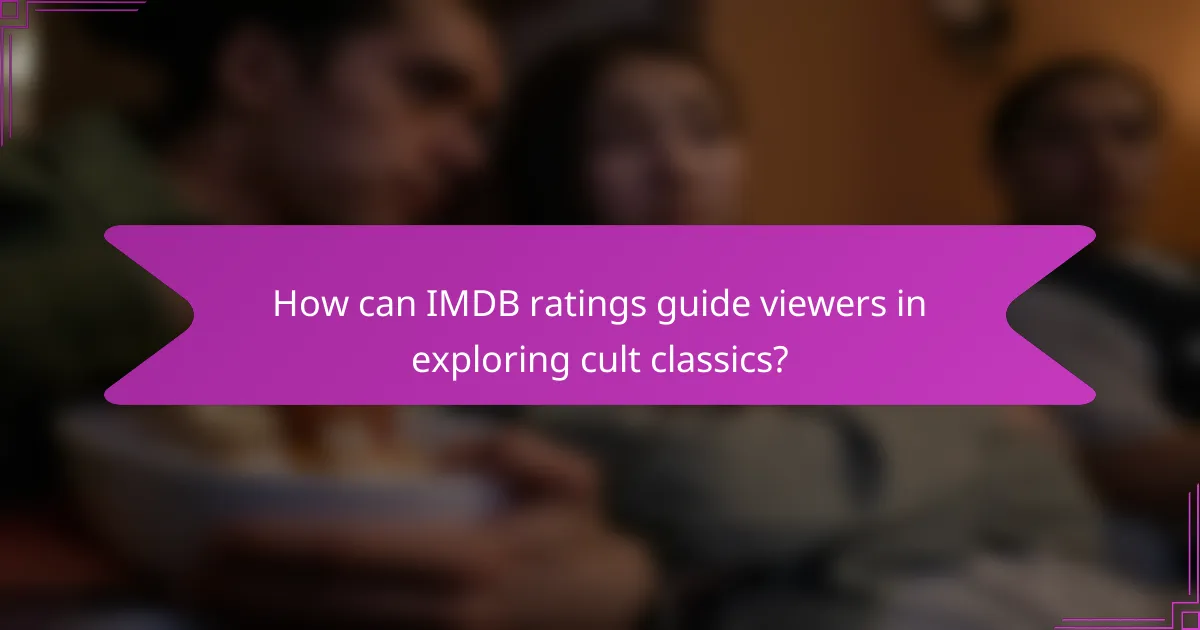
How can IMDB ratings guide viewers in exploring cult classics?
IMDB ratings can significantly assist viewers in discovering cult classics by providing a quick reference to a film’s popularity and viewer reception. While ratings alone don’t determine a film’s cult status, they can highlight hidden gems that resonate with niche audiences.
Rating thresholds for cult status
Cult classics often have IMDB ratings that range from the low fives to the high sevens. Films that fall within this range may not have mainstream appeal but possess unique qualities that attract dedicated fan bases. A rating below five might indicate a film that is poorly received, while ratings above seven could suggest broader acclaim.
When evaluating a film’s cult potential, consider not just the score but also the number of ratings. A film with a rating of 6.5 based on a few hundred votes might not carry the same weight as one rated 6.0 with thousands of votes, indicating a more established following.
Viewer reviews and community engagement
Viewer reviews on IMDB provide valuable insights into the aspects that resonate with audiences. Comments often highlight memorable quotes, unique storytelling, or unconventional characters that contribute to a film’s cult status. Engaging with these reviews can help viewers identify films that align with their tastes.
Community engagement around cult classics often occurs on social media platforms and fan forums. Participating in discussions or following hashtags related to cult films can lead to recommendations that may not be reflected in IMDB ratings alone. This interaction fosters a deeper appreciation for the films and can uncover lesser-known titles worth exploring.

What are the limitations of IMDB ratings in cult classic identification?
IMDB ratings have several limitations when it comes to identifying cult classics. While they provide a numerical score based on user reviews, these ratings can be influenced by various factors that do not necessarily reflect a film’s true cultural significance or appeal.
Subjectivity of ratings
The subjectivity of ratings is a major limitation of IMDB scores. Different viewers have varying tastes, backgrounds, and expectations, which can lead to highly divergent ratings for the same film. A cult classic may receive a low IMDB score simply because it does not cater to mainstream preferences, despite its strong following among niche audiences.
For example, a quirky indie film might resonate deeply with a small group of fans while being dismissed by general audiences, resulting in a polarized rating that fails to capture its cult status.
Potential for bias in reviews
Bias in reviews can significantly skew IMDB ratings, affecting the identification of cult classics. Factors such as marketing, timing of release, and even the demographics of reviewers can create an uneven playing field. Films that are heavily promoted or released during peak seasons may receive inflated ratings, overshadowing lesser-known gems.
Additionally, online communities can rally around specific films, leading to organized voting that artificially boosts ratings. This can mislead viewers who rely solely on IMDB scores to discover cult classics, as the ratings may not accurately reflect the film’s true impact or quality.
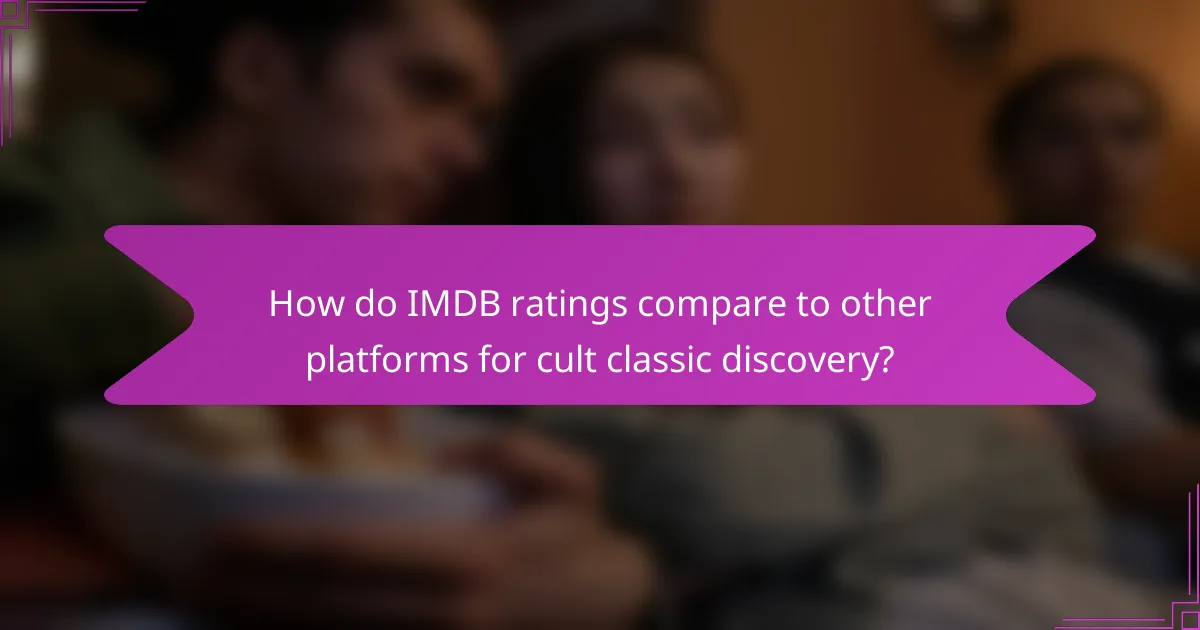
How do IMDB ratings compare to other platforms for cult classic discovery?
IMDB ratings serve as a popular benchmark for evaluating films, including cult classics, but they differ significantly from ratings on other platforms. While IMDB focuses on user-generated scores, platforms like Rotten Tomatoes and Letterboxd provide alternative perspectives that can enhance the discovery of lesser-known films.
Rotten Tomatoes ratings
Rotten Tomatoes offers a unique rating system that combines critic and audience scores, which can be particularly useful for cult classic discovery. A film with a high critic score but a low audience score may indicate a niche appeal, suggesting it could be a cult classic. For example, films that score around 60% or higher from critics but have mixed audience reactions often attract dedicated followings.
When exploring cult classics, consider both the Tomatometer and the audience score. A film with a high Tomatometer but a lower audience score may indicate critical acclaim that hasn’t translated into mainstream popularity, making it a potential gem for cult film enthusiasts.
Letterboxd user ratings
Letterboxd is a social platform where film lovers rate and review movies, making it a valuable resource for discovering cult classics. The user ratings on Letterboxd often reflect a community of cinephiles who appreciate unique storytelling and unconventional films. A film with a rating of around 3.5 stars or higher on Letterboxd can signal a strong cult following.
Engaging with Letterboxd’s lists and reviews can also provide insights into hidden gems. Users frequently compile lists of cult classics, which can guide your viewing choices and introduce you to films that may not have mainstream recognition but are beloved by dedicated fans.

What emerging trends are shaping cult classic discoveries?
Emerging trends like social media influence and streaming platform algorithms are significantly shaping how cult classics are discovered. These factors create new pathways for audiences to find and engage with films that may not have received mainstream attention upon their initial release.
Influence of social media
Social media platforms play a crucial role in the discovery of cult classics by allowing users to share recommendations and reviews. Hashtags and viral trends can elevate lesser-known films, making them popular among niche audiences. For example, a film that gains traction on TikTok can quickly become a must-watch for younger viewers.
Engagement on platforms like Instagram and Twitter also fosters community discussions around these films, often leading to organized viewings or fan events. This grassroots promotion can significantly boost a film’s visibility and longevity in popular culture.
Streaming platform algorithms
Streaming services utilize sophisticated algorithms to recommend content based on user preferences and viewing history. These algorithms can surface cult classics that align with a viewer’s tastes, often introducing them to films they might not have considered otherwise. For instance, if a user frequently watches horror films, the platform might suggest a classic horror title that has developed a cult following.
Moreover, curated lists and themed collections on streaming platforms can highlight cult classics during specific seasons or events, further enhancing their discoverability. Users should explore these curated options to find hidden gems that may have slipped under the radar.
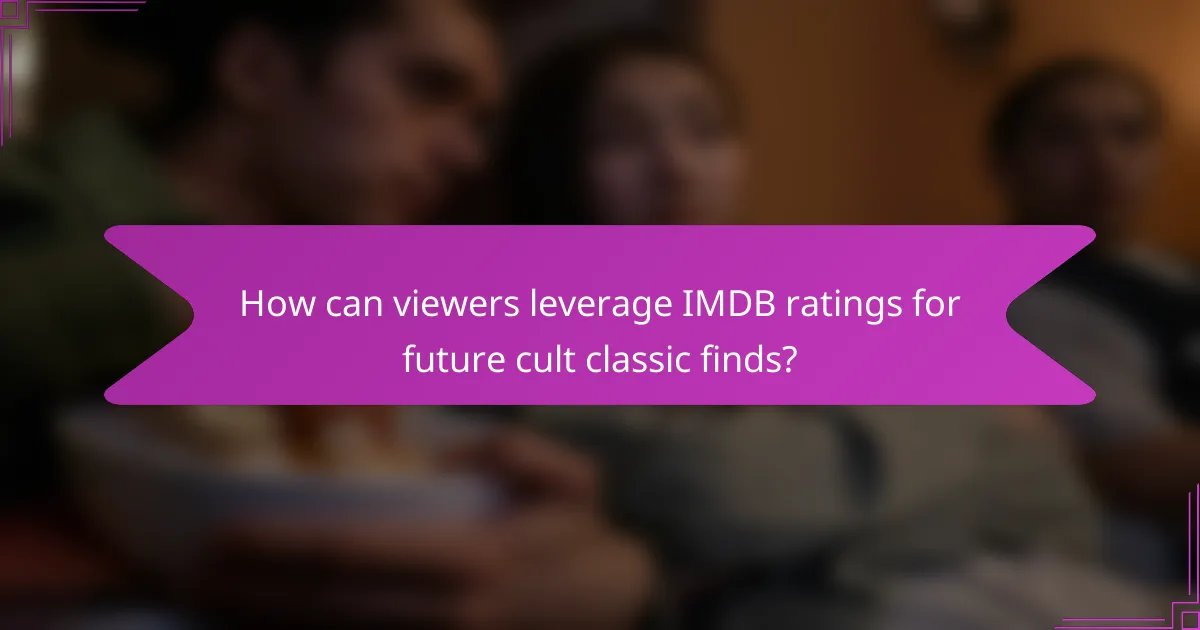
How can viewers leverage IMDB ratings for future cult classic finds?
Viewers can effectively use IMDB ratings to discover potential cult classics by analyzing user scores and reviews. High ratings combined with niche genres or unique storytelling often indicate films that may gain a dedicated following over time.
Creating personalized watchlists
Building personalized watchlists based on IMDB ratings allows viewers to curate their own collection of potential cult classics. Start by searching for films with ratings above a certain threshold, such as 7 or 8 out of 10, and filter by genres that interest you, like sci-fi or horror.
Consider adding films that have a significant number of ratings but are lesser-known. This combination often leads to hidden gems that resonate with specific audiences. Regularly update your watchlist as new films are released and gain traction on IMDB.
Engaging with fan communities
Joining fan communities dedicated to cult classics can enhance your discovery process. Platforms like Reddit, Facebook groups, or specialized forums often discuss underrated films and share recommendations based on IMDB ratings.
Participate in discussions and ask for suggestions from fellow fans. Many cult classics gain popularity through word-of-mouth, and engaging with these communities can provide insights into films that might not have mainstream recognition yet.
